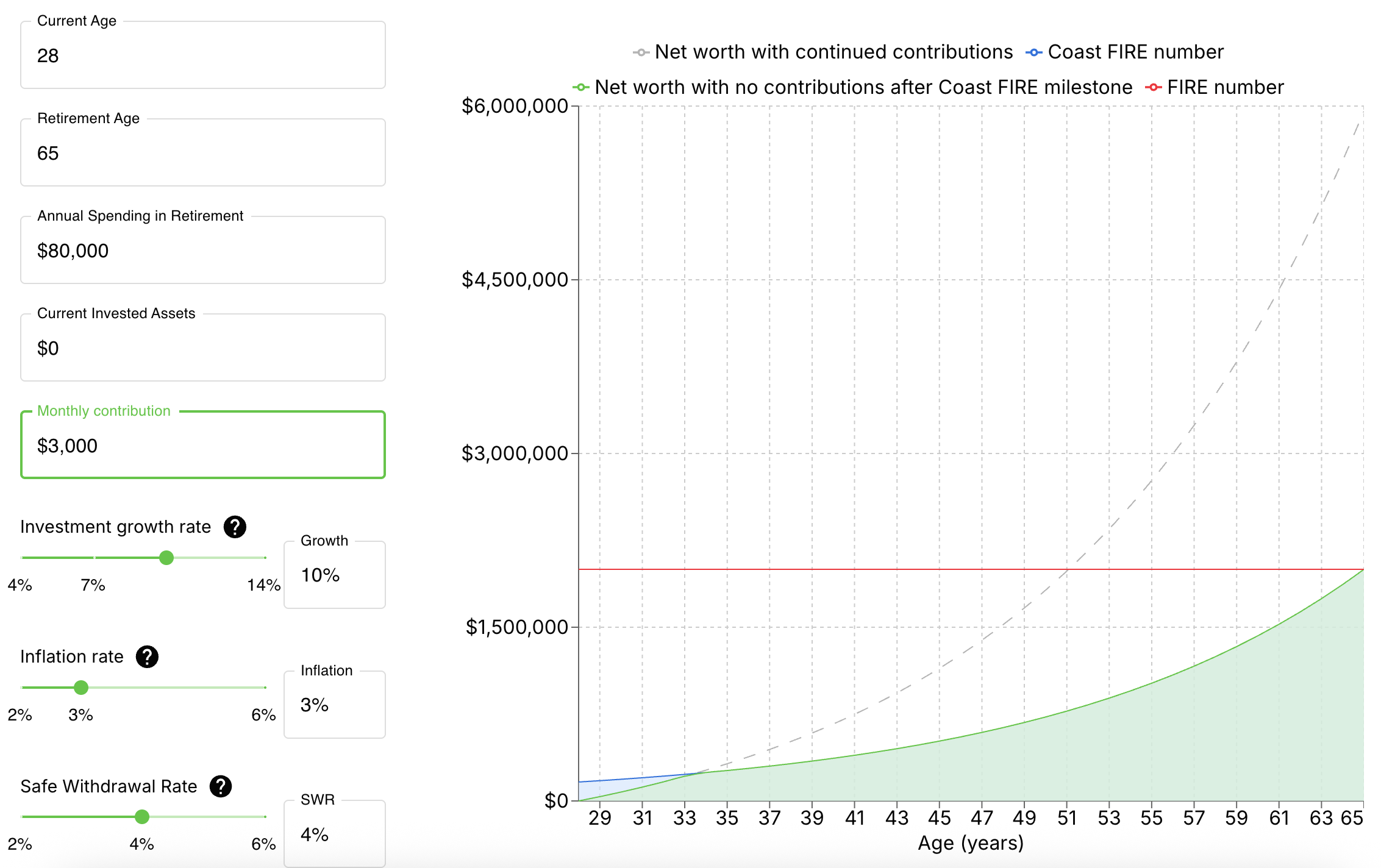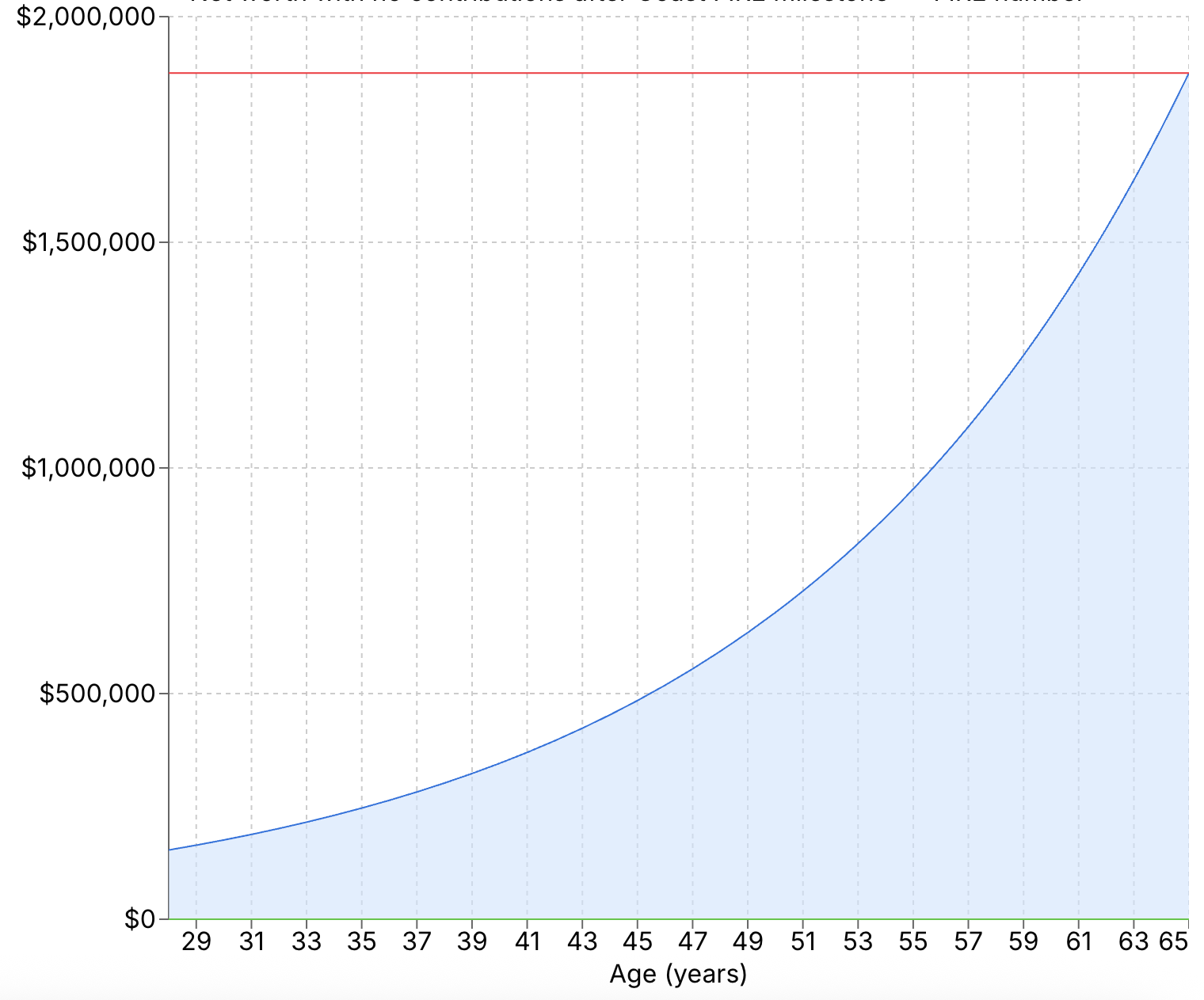Coast FIRE by Age: A Smarter, Low-Stress Path to Financial Freedom
Photo by Taryn Elliott on Pexels.
Reading time: 9 minutes
Disclaimer: I am not a financial adviser, and the content in this website is for informational and educational purposes only. Please consult a qualified financial adviser for personalized advice tailored to your situation.
🌿 Thanks for reading The Good Life Journey. I share weekly insights on money, purpose, and health, to help you build a life that compounds meaning over time. If this resonates, join readers from over 100 countries and subscribe to access our free FI tools and newsletter.
👉 New to Financial Independence? Check out our Start Here guide—the best place to begin your FI journey.
What Is Coast FIRE and How Does It Work?
Why Coast FIRE Is Gaining Popularity in the FIRE Community
In today’s post, we will review in depth the benefits of pursuing Coast FIRE (financial independence, retire early) and provide you with easy-to-understand numbers that you can tailor to your specific situation. By the end of the post, you will have a solid understanding of why so many in the FI community chose this alternative FIRE approach. I will also share whether I am personally on board this FI strategy or whether I am following a different approach.
In previous blog entries, we saw that burnout can be quite prevalent in the FI community, with many individuals aspiring to reach FIRE but taking their journey too far and ending up unhappy. On the one hand, it is understandable that they want to reach this desirable goal as quickly as possible, given that a large majority of employees report feeling stressed and do not find fulfilment in their current job. But, of course, nobody wants to work towards this goal while risking their physical or mental wellbeing. We also don’t want to look back with regret, realizing we may have “wasted” some of our best years at a younger age to pursue a high level of security at an older, more frail time of our lives. So, is it possible to strike a balance here?
In this context, pursuing either Barista FIRE or Coast FIRE could be a suitable alternative for many individuals that allows them to reach their financial goals whilst not postponing their ability to enjoy the journey over the decades and still manage to satisfy many of life’s highlights and milestones.
Understanding Coast FIRE: How It Works and Who Benefits Most
At its core, Coast FIRE is a popular financial strategy where you save aggressively early, then stop investing and let compound interest grow your retirement fund. This is what is referred to as “coasting”–you are essentially letting your nest egg compound and grow, but not actively adding to it through your savings rate.
Under this scenario, once you reach your Coast FIRE number, you continue working but–unlike previous years–100% of your net home pay is dedicated to covering your living expenses, letting you live a higher standard of living on the path to financial independence. Coast FIRE is ideal for people who enjoy their work and want financial security without quitting their job early. For those of you who really dislike your job, I think a Barista FIRE approach is better-suited alternative to the traditional FIRE pathway.
When you pursue Coast FIRE, you are limiting the intensive savings phase of the FI journey early on to a limited number of years. Ideally, the sooner you start the better, since it allows compounding to do the heavy lifting and means you have to contribute a smaller amount of funds to your investments before reaching your Coast FIRE age.
Photo by Los Muertos Crew on Pexels.
Coast FIRE Example with Real Numbers: A Case Study
Let’s use a simple case study to illustrate the Coast FIRE concept (depicted below in Figure 1). Using this Coast FIRE calculator, we will model a young couple’s financial path. Let’s consider a household with the following characteristics:
Age: 28
Desired retirement age: 65
Annual spending in retirement: $80,000
Current invested assets: $0
Monthly contributions to investments: $3,000
Real return on investments of low-coast, internationally diversified index fund portfolio: 7%
In this example, given the $80,000 annual spend targeted for retirement, the household needs to accumulate a nest egg of $2M by the time they retire (red line of Figure 1), as per the 4% rule of thumb ($80,000/0.04).
The dashed grey line in Figure 1 illustrates how your net worth might grow if you keep contributing to your investments beyond reaching Coast FIRE. Instead, though, the household reaches Coast FIRE in this example at age 34, after only 6 years of aggressive investing (blue line). After this point, their nest egg is allowed to grow in the background at a 7% annual return. This trajectory is depicted by the green line, and, as we can see in the figure, it crosses the $2M milestone at retirement (age 65).
Not bad! This example shows how a short period of high savings can unlock long-term financial freedom. After 6 years they would have an additional $3,000 to spend at will, potentially increasing their lifestyle.
Figure 1: Example of Coast FIRE. Save aggressively for six years until age 34, then let compound interest grow your portfolio without additional contributions. From age 34 to 60, you will be able to enjoy a substantially higher standard of living, as a result of not having to focus on saving and investing any more.
How Much You Need by Age to Reach a $2M Coast FIRE Goal
Alright, now that we understand how the concept works, let’s try to generalize this approach and unpack different Coast FIRE trajectories by age. Again, these are the amounts you would need to accumulate by each age to be able to drop your investment contributions and still be on track to make it safely to retirement by age 65 with a portfolio of $2M.
Table 1: Coast FIRE numbers (thousands of $) by age to reach $2M by age 65. Assumes 7% return and 4% SWR.
| Age | 25 | 30 | 35 | 40 | 45 | 50 | 55 | 60 | 65 |
|---|---|---|---|---|---|---|---|---|---|
| Coast FIRE Portfolio ($ thousands) | 134 | 187 | 263 | 368 | 517 | 725 | 1,017 | 1,426 | 2,000 |
Notice that Table 1 shows how required savings increase exponentially with age for Coast FIRE (Figure 2, blue). The later you discover FIRE or start savings and investing to achieve Coast FIRE, the more difficult it will be to implement this plan, since it requires an outsized effort the older you are. If you are 25 years old, you can stop your contributions after reaching only $134,000, whereas if you are 45 you would need a nest egg of $517,000!
Figure 2. Coast FIRE by age. The earlier you start saving and investing aggressively, the easier it is to reach Coast FIRE and drop the monthly contributions and still make it to retirement with the targeted portfolio (in this case, $2M)
Coast FIRE Portfolio Values by Age and Retirement Spending
Next, we present in Table 2 below an overview of the amount of investments by age needed to reach Coast FIRE for different retirement spendings. To illustrate, imagine you enjoy your job and plan to retire by age 65. Let’s suppose you need $80,000 in retirement (and therefore a target portfolio of $2M), and wish to reach Coast FIRE by age 40. According to Table 2, this means you would need to have invested $368,000 by then. From that point onwards, you could stop investment contributions and this amount would compound over time, still reaching your desired goal by age 65.
Table 2. Cost FIRE portfolio value by age (in thousands $). For example, If you need $80,000 in retirement (and therefore target a portfolio of $2M), and wish to reach Coast FIRE by age 40, you would need to have invested $368,000 by then. From that point onwards, you could stop investment contributions and still reach your desired goal by age 65.
As mentioned earlier, the sooner you start the better. As illustrated by Figure 2 above, there is a non-linear relationship between the age you start saving and investing and the end retirement portfolio.
In contrast, for any given age, the relationship between the portfolio target and the Coast FIRE number needed is linear. For example, you need $100,000 by age 25 to reach a target portfolio of $1.5M by age 65; but, if you wanted to spend twice that amount in retirement instead (i.e., target a $3M by age 65) you would need exactly twice the amount invested by age 25, i.e., $200,000. This means there isn’t a non-linear benefit for choosing a leaner Coast FIRE number here.
For those who already have substantial amounts invested, the table can be used differently. Let’s imagine you are 35 and already have $320,000 invested in low coast, internationally diversified index funds. Looking at the table, this means if you stopped your investment contributions today (and therefore substantially increased your lifestyle), you could still reach a sizeable nest egg of about $2.5M (in today’s dollars) by age 65.
Top Benefits of Reaching Coast FIRE Early
There are several advantages of pursuing Coast FIRE, many of which depend on each individual’s personal circumstances and preferences:
It provides peace of mind. Knowing your retirement is covered can alleviate substantial and long-term financial anxiety and bring a sense of security.
It can reduce mid-life savings pressure, making it ideal for families facing rising expenses, while still allowing a comfortable lifestyle compared to the traditional FI pathway. If you save aggressively early on, you substantially raise your spending during those expensive years with kids.
Coast FIRE can make a lot of sense for those few who actually enjoy their career. If you like what you do for a living, there is, of course, less of an incentive to want to pursue traditional FIRE to retire early. Why not enjoy today the fruits of your labor instead of postponing it for a less certain–and more frail–future?
Increased ability to take risks. With your retirement in autopilot, you may feel more capable at taking risks, e.g., starting a new business, going back to school, or moving to a part-time, lower-paying, but more fulfilling job. Granted, the latter case would represent a transition towards Barista FIRE.
Greater career freedom and flexibility. Coast FIRE allows for career breaks like sabbaticals or mini-retirements without derailing your long-term financial goals.
Potential for geographic freedom. Coast FIRE can also enable geographic arbitrage, i.e., moving to a lower cost-of-living location or traveling, without needing to be tied to a high-paying, high-stress job or location.
Can you think of any other advantage? Please share with us below in the comments!
Photo by Holly Mandarich on Unsplash.
Coast FIRE Risks and Potential Downsides to Consider
While Coast FIRE offers many benefits, there are also some drawbacks to be aware of. Depending on your financial situation, lifestyle, and goals, it may be a good idea to consider some of the potential drawbacks:
Requires early aggressive saving. Coast FIRE definitely demands significant discipline and front-loaded effort. Living substantially below your means in your 20s or 30s can definitely feel restrictive for some. This is also an age when many life milestones and experiences are taking place, and potentially missing out on some of them may be a tradeoff to consider.
Sensitive to market returns and inflation. Given that your investments are expected to grow untouched for many years (i.e., decades in many cases), Coast FIRE does rely heavily on favorable long-term market conditions. Other approaches such as traditional FIRE or Barista FIRE could allow for more flexibility and regular adjustments to the plan as market conditions shift.
Limited margin for error. Once you reach Coast FIRE and stop your regular investment contributions, you are removing your biggest lever, i.e., your ongoing saving, and locking yourself in with a certain portfolio target. But keep in mind that your financial goals and needs at age 50 may end up being different than what you had predicted in your 20s or early 30s. Unexpected life events and costs can disrupt Coast FIRE if there’s no margin of safety.
Not ideal for late starters. This may be just the opposite of the first item, but still worth stressing. Starting FIRE late in life can make Coast FIRE difficult without substantial savings or a very high savings rate. For these cases, it is likely that traditional or Barista FIRE may be more suitable.
Did I miss any disadvantage? Please let us know in the comments below!
Is Coast FIRE Right for You? Final Thoughts and Personal Insights
Coast FIRE can offer a powerful middle ground for those who are seeking FI without the pressures and sacrifices of the traditional FIRE approach. In this case, it is not about quitting work, but about quitting your savings–quite a different mind shift! By front-loading your investment efforts early on, you give yourself the opportunity for more enjoyment in your 30s, 40s, or 50s, times when key life milestones often occur.
It’s especially well suited to high earners in their 20s and 30s who genuinely enjoy their career, but don’t want to feel dependent on it forever. It’s ideal if you value mental freedom, lifestyle flexibility, and a less extreme approach to the traditional FIRE journey. Coast FIRE still rewards discipline and smart planning without requiring the level of frugality or a full early exist from the workforce.
Today’s example used age 65 for illustration, but remember that Coast FIRE is flexible. You can also pursue Coast FIRE and target an earlier retirement date based on your personal goals and lifestyle. But, of course, there is no free lunch here. If you bring the retirement data forward too much, there is less of a runway for your portfolio to compound in the background, and, therefore, a substantially larger initial nest egg is required to reach Coast FIRE.
Personally, I’ve chosen not to follow Coast FIRE due to job stress and a desire for early time freedom. I work in a relatively-high stress environment, so the idea of staying in this industry full time until 65 is a complete non-starter for me. The appeal of FIRE for me is to free up time as early as possible while I’m still healthy to enjoy it. Instead, as an alternative to the traditional FIRE path, I am more open to pursuing a Barista FIRE approach, where I can still work part-time in a (hopefully) lower stress environment.
Where are you on your FIRE journey? Do you feel close to your Coast FIRE number–or just getting started? Would knowing you're “done saving” give you peace of mind? Let us know in the comments below! 👇
🌿 Thanks for reading The Good Life Journey. I share weekly insights on money, purpose, and health, to help you build a life that compounds meaning over time. If this resonates, join readers from over 100 countries and subscribe to access our free FI tools and newsletter.
👉 New to Financial Independence? Check out our Start Here guide—the best place to begin your FI journey.
Also, if you’ve enjoyed today’s post, don’t miss our article on where we explain key differences between Coast FIRE and Barista FIRE or our dedicated post on Expat Barista FIRE (leveraging lower cost-of-living locations with low stress, part-time work to retire in less than 7 years!)
Check out other recent articles
Join readers from more than 100 countries, subscribe below!
Didn't Find What You Were After? Try Searching Here For Other Topics Or Articles:




































